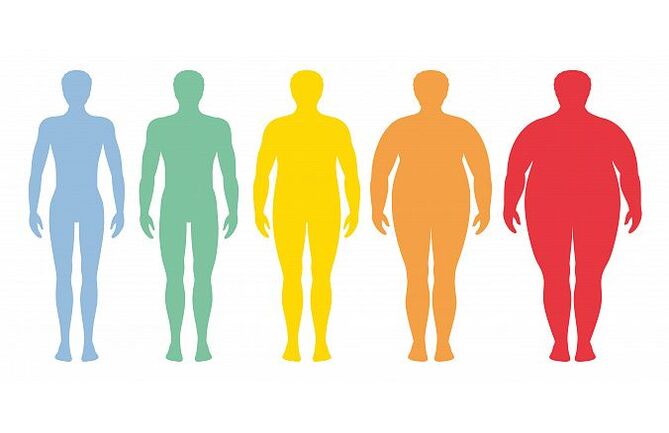Obesity is one of the most pressing problems of the modern world. In some countries it has already reached epidemic proportions. In our country, about 47% of men and 52% of women live overweight. Being overweight is not just a visual defect. It can cause many physiological or psychological disorders. To get rid of excess fat, you must first change your eating habits.

What are the dangers of obesity?
Obesity is due to the fact that the amount of food entering the body of a modern person significantly exceeds the amount required to produce energy. This converts the unused residue into fat. The quality of the products consumed also plays a role. If the basis of the diet consists of easily digestible carbohydrates, they are sure to be deposited in the form of unsightly wrinkles.
Being overweight shouldn't just be seen as a visual disadvantage. It is a risk factor for the development of many diseases. The more fatty tissue grows, the greater its destructive effect on the body.
Attention: Compared to people of normal weight, patients who are overweight are three times more likely to suffer from diabetes mellitus and twice as likely to suffer from diseases of the liver and cardiovascular system.
Obesity is a systemic disease; it can affect the function of all internal organs.
Diseases caused by excess weight include:
- Hypertension;
- Alzheimer's disease;
- strokes;
- Arthritis;
- male impotence;
- phlebeurysm;
- angina pectoris;
- pathologies of the respiratory system;
- Depression;
- Apnea (sudden cessation of breathing during sleep);
- Heart attack;
- pathology of the gallbladder;
- Arthrosis;
- diseases of the digestive tract;
- Arteriosclerosis;
- Menstrual irregularities.
It has been scientifically proven that obesity increases the likelihood of developing breast, thyroid, colon, gallbladder and kidney cancer. The most clearly visible connection is between obesity and malignant neoplasms of the esophagus and uterine lining. On average, body fat reduces a person's life expectancy by 12-15 years.
To make matters worse, overweight people have a disturbed metabolism - this slows down the process of losing weight. But the situation is reversible. It is possible to "lose" even the heaviest weight. To do this, you must first change your diet. The main mistake that many people make is that they try to avoid eating completely. This replaces periods of fasting with time off. The weightreturns in even larger quantities and health problems arise. A professional nutritionist should select a diet for an overweight person.

Basic principles of nutrition for obesity
The diet to treat obesity must be balanced. The body cannot remain without vital substances, amino acids and vitamins. An incorrectly chosen diet can lead to serious endocrine disorders, dysfunction of the liver, heart and other organs.
The basic nutritional rules for normalizing weight are as follows:
- The daily calorie content is between 1700 and 2000 kcal. It is calculated individually, taking into account the patient's gender, age, height, physique and physical activity;
- limiting consumption of foods containing fast carbohydrates and animal fats;
- Fill the diet with fiber, which is low in calories but fills the stomach for a long time and creates a feeling of satiety.
- The recommended protein intake per day for an adult with average physical activity is 0. 75 g per 1 kg of weight;
- Split meals make it easier to control hunger. It is advisable to eat 5-6 times a day;
- the daily amount of salt should not exceed 5 g;
- Exclusion of spices, herbs, smoked foods, pickles and spicy dishes that increase appetite;
- You should drink one and a half liters of water per day. Before each meal you should slowly drink half a glass of liquid;
- Boil, bake or steam all dishes. Fried foods should be avoided;
- eat at the same time. Additional snacks are prohibited.
Attention: The norm is a monthly weight loss of 3 kg through fat. Losing weight faster is a big burden on the body!
A healthy diet to combat obesity must be combined with measured physical activity. You need to start with 10 minutes of training and gradually increase the duration and complexity of the exercises.
The listed rules must be observed particularly strictly in the first month of treatment. Then the body adjusts to the new diet and daily routine. The risk of breakdowns and a return to previous eating habits will decrease.

Prohibited and permitted products
The so-called nutritional table No. 8 is usually recommended for overweight patients. It directly serves to reduce fat volume and normalize metabolic processes.
Attention: Individual diets are chosen for patients with concomitant diseases of the cardiovascular system, liver and digestive organs!
Despite the strictness of this diet, it allows for a varied and tasty diet. The list of acceptable products is very extensive. We present the most important ones to you in a table.
| Product group | allowed | forbidden |
| flour products | Black or wholemeal bread (up to 150 g per day) | White bread; Bakery products; puff pastry |
| Meat | lean beef; rabbit meat; Chicken meat without skin and fat; Turkey; (any, up to 150 g per day) | Pork meat; Goose; Duck; mutton; smoked meat; sausages; Stew; salo |
| Fish | low-fat varieties (up to 150 g per day); Seafood (up to 200g per day) | all fat breeds; salted, smoked fish; Canned food |
| Vegetables | cabbage; cucumbers; Radish; Zucchini; Pumpkin; Tomatoes; Turnip; Green; seaweed | Potato; carrots (occasionally allowed); green pea |
| Side dishes | buckwheat; pearl barley; barley semolina; green beans | Pasta; Rice; Semolina; legumes |
| Eggs | cooked | Fried eggs; fried omelette; |
| fruits and berries | sour fruits and berries; Jelly; Mousses | Grape; bananas; figs; Events |
| beverages | Coffee; Tea; natural juices from sour fruits and berries; Mineral water; Rosehip decoction | sweet compotes; Jelly; packaged juices; lemonade |
| Spices | sauces with herbs in weak broth; Tomato sauce; white sauce with vegetables | Mayonnaise; Mustard; Horseradish; Ketchup |
| Dairy products | Kefir; Curdled milk; Cottage cheese (all low fat) | hard cheese; Sour cream; whole milk; cream |
It's good to make the menu in advance, buy all the products and divide them into meals. In this case, you do not need to "rush" to prepare food after work - this can lead to overeating.
Sample menu for the day
Breakfast
- cooked meat (100 g)
- baked beets
- sugar-free coffee
Lunch
- vegetable stew
- baked fish (100 g)
- fruit jelly
Dinner
- Borscht without meat (150 g)
- low-fat cottage cheese
- Dried fruit compote
Afternoon snack
- fresh apples
Dinner
- Carrot salad with garlic
- buckwheat
Before going to bed, you should drink a glass of low-fat kefir.
Alternative diets
There are many options for a low-carb diet. Diets that are not too strict involve the exclusion of so-called fast carbohydrates. The principle of drawing up a diet is similar to the "Table No. 8" described above. Such restrictions are really useful. They allow the body to receive all the necessary substances and burn stored fat reserves.
Another type of low-carb diet is strict. They exclude almost all products that contain these substances. The basis of a protein diet, for example, is proteins. They make up up to 80% of the daily diet. Such foods fill you up quickly, take a long time to digest and relieve hunger. In addition, processing plant and animal proteins requires a lot of energy - this uses up to half of the calories consumed.
Such diets are effective, but they must be combined with serious physical activity. Otherwise, proteins that are not used for muscle mass form nitrogen-containing compounds that are excreted via the kidneys. The load on the organs increases and creates the conditions for the development of urolithiasis.
A lack of carbohydrates negatively affects the condition of bones, skin and hair. From these chemical compounds, the body produces glucose, the main nutrient for the brain. When there is a lack of energy, the body begins to use not only subcutaneous fat for its production, but also muscle tissue.
The popular keto diet, which involves completely avoiding carbohydrates, is not recommended for beginners. Only fats and proteins of plant and animal origin may be consumed. The purpose of such a diet is to bring a person into a state of ketosis. This is a type of metabolism in which the body uses ketone bodies (subcutaneous fat derivatives) instead of glucose. The diet is also harmful because, in addition to carbohydrates, a person also stops consuming fiber, vitamins and microelements contained in the excluded products.
It is possible to lose weight on such a diet, but achieving this through complex physiological changes is undesirable. The diet was originally developed for patients with epilepsy because a link between ketosis and a reduction in seizure frequency was found. The keto diet is not recommended for weight loss, but solely for therapeutic purposes.
In any case, it is better to consult your doctor before starting this diet. Not everyone can restrict their diet.
Who are diets contraindicated for?
Strict diets are contraindicated in many diseases, as well as in certain periods of human development.
Firstly, you cannot stick to a low-calorie and restrictive diet in childhood. The foundations of metabolism are laid during intensive growth. Lack of nutrients can lead to underdevelopment of the skeleton and internal organs and cause chronic diseases.
In adolescents, a lack of fats and carbohydrates leads to improper synthesis of sex hormones. In adulthood, this can lead to an unstable menstrual cycle and reproductive problems.
Most women gain weight during menopause. This is because hormonal imbalance affects all processes in the body, including fat metabolism. Strict diets during menopause are not only harmful, but also useless. You can stop weight fluctuations only by taking estrogen medications recommended by your gynecologist.
A restricted diet for pregnant and breastfeeding women is strictly prohibited. A nutrient deficiency during pregnancy can have a negative impact on the course of the pregnancy. Additionally, malnutrition often results in the birth of a weakened child with neurological problems, immune problems and developmental delays.
In nursing mothers, weight usually normalizes on its own within a year, since the accumulated reserves are "used up" by the body for milk production with a reasonable, balanced diet. Dietary restrictions can lead to hormonal imbalance and even greater weight gain.
There are specific diets for patients with certain chronic diseases. Among the pathologies:
- Gastritis;
- heart disease;
- Ulcer;
- intestinal diseases;
- Kidney diseases;
- pathologies of the liver and gallbladder;
- Pancreatitis.
People with diabetes and thyroid dysfunction cannot experiment with nutrition on their own. In these cases, weight correction occurs under the strict supervision of the attending physician, who selects a suitable therapeutic diet for the patient.
How to lose weight without dieting
In most cases, in order to lose weight, it is not necessary to impose strict restrictions on the body. It is enough to minimize the consumption of fast food, processed foods, cream cakes and other unhealthy foods.
If you follow a few simple rules, you will achieve your ideal figure:
- Drink enough clean water. This not only provides the cells with the necessary moisture, but also reduces appetite;
- Exercise helps boost your metabolism. It is enough to spend 10-15 minutes doing exercises every day;
- Eat often in small portions. Don't eat while reading or watching TV. This way you can get distracted and eat much more than you need;
- Spend more time in the fresh air and breathe deeper. As a result, the tissue is saturated with oxygen, metabolic processes occur faster;
- Sleep well;
- Don't force yourself to finish eating. It's good to take short breaks while eating; if you feel full, you've had enough to eat.
Between lunch and dinner, you can suck on a few slices of dark chocolate with a high cocoa butter content (at least 70%). You can replace it with several dried fruits; these must be chewed slowly. This gives the brain a signal that there is enough glucose and the appetite decreases.
Obesity is not just a harmless cosmetic defect. This is a dangerous pathology that can lead to disability and premature death of the patient. It is necessary to normalize weight, but the thoughtless desire for an ideal figure can be no less harmful to a person's health than fatty deposits. You need to lose weight properly under the supervision of a qualified nutritionist.

















